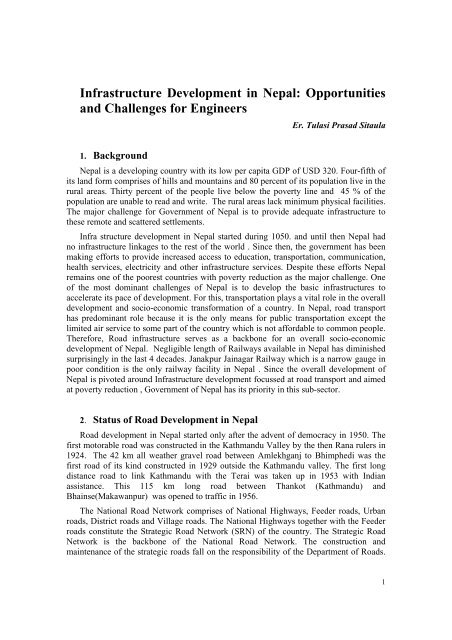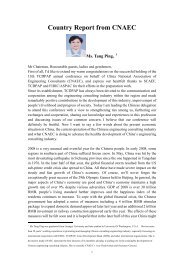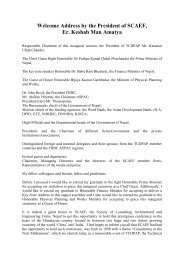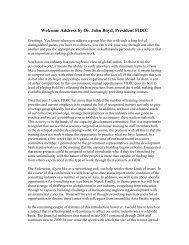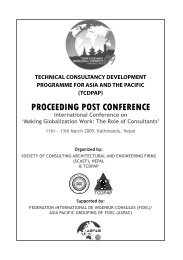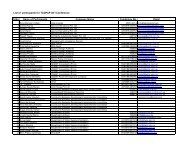Infrastructure Development in Nepal - Society Of Consulting ...
Infrastructure Development in Nepal - Society Of Consulting ...
Infrastructure Development in Nepal - Society Of Consulting ...
Create successful ePaper yourself
Turn your PDF publications into a flip-book with our unique Google optimized e-Paper software.
<strong>Infrastructure</strong> <strong>Development</strong> <strong>in</strong> <strong>Nepal</strong>: Opportunities<br />
and Challenges for Eng<strong>in</strong>eers<br />
Er. Tulasi Prasad Sitaula<br />
1. Background<br />
<strong>Nepal</strong> is a develop<strong>in</strong>g country with its low per capita GDP of USD 320. Four-fifth of<br />
its land form comprises of hills and mounta<strong>in</strong>s and 80 percent of its population live <strong>in</strong> the<br />
rural areas. Thirty percent of the people live below the poverty l<strong>in</strong>e and 45 % of the<br />
population are unable to read and write. The rural areas lack m<strong>in</strong>imum physical facilities.<br />
The major challenge for Government of <strong>Nepal</strong> is to provide adequate <strong>in</strong>frastructure to<br />
these remote and scattered settlements.<br />
Infra structure development <strong>in</strong> <strong>Nepal</strong> started dur<strong>in</strong>g 1050. and until then <strong>Nepal</strong> had<br />
no <strong>in</strong>frastructure l<strong>in</strong>kages to the rest of the world . S<strong>in</strong>ce then, the government has been<br />
mak<strong>in</strong>g efforts to provide <strong>in</strong>creased access to education, transportation, communication,<br />
health services, electricity and other <strong>in</strong>frastructure services. Despite these efforts <strong>Nepal</strong><br />
rema<strong>in</strong>s one of the poorest countries with poverty reduction as the major challenge. One<br />
of the most dom<strong>in</strong>ant challenges of <strong>Nepal</strong> is to develop the basic <strong>in</strong>frastructures to<br />
accelerate its pace of development. For this, transportation plays a vital role <strong>in</strong> the overall<br />
development and socio-economic transformation of a country. In <strong>Nepal</strong>, road transport<br />
has predom<strong>in</strong>ant role because it is the only means for public transportation except the<br />
limited air service to some part of the country which is not affordable to common people.<br />
Therefore, Road <strong>in</strong>frastructure serves as a backbone for an overall socio-economic<br />
development of <strong>Nepal</strong>. Negligible length of Railways available <strong>in</strong> <strong>Nepal</strong> has dim<strong>in</strong>ished<br />
surpris<strong>in</strong>gly <strong>in</strong> the last 4 decades. Janakpur Ja<strong>in</strong>agar Railway which is a narrow gauge <strong>in</strong><br />
poor condition is the only railway facility <strong>in</strong> <strong>Nepal</strong> . S<strong>in</strong>ce the overall development of<br />
<strong>Nepal</strong> is pivoted around <strong>Infrastructure</strong> development focussed at road transport and aimed<br />
at poverty reduction , Government of <strong>Nepal</strong> has its priority <strong>in</strong> this sub-sector.<br />
2. Status of Road <strong>Development</strong> <strong>in</strong> <strong>Nepal</strong><br />
Road development <strong>in</strong> <strong>Nepal</strong> started only after the advent of democracy <strong>in</strong> 1950. The<br />
first motorable road was constructed <strong>in</strong> the Kathmandu Valley by the then Rana rulers <strong>in</strong><br />
1924. The 42 km all weather gravel road between Amlekhganj to Bhimphedi was the<br />
first road of its k<strong>in</strong>d constructed <strong>in</strong> 1929 outside the Kathmandu valley. The first long<br />
distance road to l<strong>in</strong>k Kathmandu with the Terai was taken up <strong>in</strong> 1953 with Indian<br />
assistance. This 115 km long road between Thankot (Kathmandu) and<br />
Bha<strong>in</strong>se(Makawanpur) was opened to traffic <strong>in</strong> 1956.<br />
The National Road Network comprises of National Highways, Feeder roads, Urban<br />
roads, District roads and Village roads. The National Highways together with the Feeder<br />
roads constitute the Strategic Road Network (SRN) of the country. The Strategic Road<br />
Network is the backbone of the National Road Network. The construction and<br />
ma<strong>in</strong>tenance of the strategic roads fall on the responsibility of the Department of Roads.<br />
1
Thee district roads together with village roads constitutes the District Road Network. At<br />
present the National Road Network has altogether 24000 km (30% blacktop, 27% gravel<br />
and 43% earthen roads) <strong>in</strong> 2008. The strategic, urban and local roads share 32.5%, 13%<br />
and 54.5% respectively <strong>in</strong> the National Road Network.<br />
The Strategic Road Network serves as the backbone of the National Road Network.<br />
The strategic roads have high traffic volume <strong>in</strong> comparison to district roads. There are 15<br />
National Highways and 51 Feeder roads totall<strong>in</strong>g 8000 km <strong>in</strong> the Strategic Road<br />
Network. The government plans to <strong>in</strong>crease the length of SRN to 12000 km by the year<br />
2017.<br />
Local Road Network (LRN), comprises of District Roads, those urban roads not <strong>in</strong>cluded<br />
<strong>in</strong> SRN, village roads, agriculture roads, mule trails and tracks, Trail Bridges, Ropeway<br />
etc. With the advent of Multiparty democracy <strong>in</strong> 1989, there has been a tremendous<br />
demand of construct<strong>in</strong>g roads <strong>in</strong> rural areas. Though there are District Transport Master<br />
Plans prepared by the districts the growth of LRN is quite haphazard.<br />
Road development status of <strong>Nepal</strong> is not satisfactory compared to the south Asian<br />
countries. <strong>Nepal</strong> has a very low road density of 6.39 km per 100 sq km thus <strong>in</strong>dicat<strong>in</strong>g<br />
poor accessibility to various parts of the country. At the end of first year of eleventh plan<br />
6 district head quarters namely Bajura, Dolpa, Mugu, Humla, Manang, Solukhumbu are<br />
still lack<strong>in</strong>g road connection. The Eleventh plan aims to road l<strong>in</strong>k the 3 district<br />
headquarters namely Bajura, Manang and Solukhumbu this year and the rema<strong>in</strong><strong>in</strong>g three<br />
headquarters by the end of the eleventh plan that is 2010.<br />
The status of Strategic Road Network based on type of pavement is presented <strong>in</strong><br />
Chart 1<br />
Functional SRN pavement Type<br />
33%<br />
45%<br />
Black top<br />
Gravel<br />
Earthen<br />
22%<br />
2
Present scenario of total Road Network, SRN and LRN with respect to pavement<br />
category is shown <strong>in</strong> Chart 2<br />
Total Road Network Pavement type<br />
18%<br />
72%<br />
10%<br />
Black top<br />
Gravel<br />
Earthen<br />
The comparative Chart of Strategic Road Network length is shown <strong>in</strong> table 1<br />
Table 1: The comparative Chart of Strategic Road Network length,<br />
Influenced Population and Density ( 1998-2006/7)<br />
Year<br />
AD<br />
Description<br />
1998 9 th five yr<br />
plan<br />
Length<br />
BT GR ER<br />
Total<br />
Influenced<br />
population<br />
(No. per<br />
Km)<br />
Density<br />
Km/100<br />
sq km<br />
2905 1656 179 4740 3901 + 3.22<br />
2000 2974 1649 171 4794 3857 + 3.26<br />
2002 10 th five yr<br />
plan<br />
3029 1664 168 4861 4763 ++ 3.30<br />
2004 3495 883 614 4992 4636 ++ 3.39<br />
2006/07 4258 2062 3079 9399 2463 ++ 6.39<br />
Population census 1991 +<br />
3
Population census 2001 ++<br />
S<strong>in</strong>gapore has the highest road density of 462 km per 100 sq km. <strong>Nepal</strong> is ranked 29 th<br />
<strong>in</strong> Asia after Bhutan and Lao PDR. Compared on the basis of percentage of paved road,<br />
<strong>Nepal</strong> lies much beh<strong>in</strong>d <strong>in</strong> the region.<br />
3. The Legal Frameworks<br />
Infra structure development has rema<strong>in</strong>ed a priority of the government right from the<br />
beg<strong>in</strong>n<strong>in</strong>g of first five year plan. With a view to facilitate and to create enabl<strong>in</strong>g<br />
environment many legislations have been enacted s<strong>in</strong>ce then. Rules. Regulations and<br />
Guidel<strong>in</strong>es have been developed and put to use. Policy documents have been passed<br />
and practised so as to streaml<strong>in</strong>e the direction of the development. In this connections<br />
the follow<strong>in</strong>g Acts , Regulations, policy frameworks etc. have been brought <strong>in</strong> place:<br />
1 Public Roads Act, 2031<br />
2 Local self Governance Act 2054 and Regulations 2055<br />
3 Public Procurement Acts 2063 and Regulations 2064<br />
4 Contract Act, 2023 and 2058<br />
5 Construction Industry Acts 2055<br />
6 Private Investment <strong>in</strong> <strong>in</strong>frastructure, Build and Operate Ord<strong>in</strong>ance 2060<br />
7 BOOT Acts 2063 and Regulations 2064<br />
8 Roads Board Act 2059<br />
9 Eng<strong>in</strong>eer<strong>in</strong>g Council Acts 2055 and Regulations 2057<br />
10 Road Sector Policy 1999<br />
11 Public <strong>Infrastructure</strong> Build, Operate and Transfer Policy 2057<br />
12 Priority Investment Plan 1997- 2007<br />
13 Priority Investment Plan 2007 – 2017<br />
14 The Department of Roads Strategy 1995<br />
15 Road Ma<strong>in</strong>tenance Tra<strong>in</strong><strong>in</strong>g Policy 2001<br />
16 Human Resource <strong>Development</strong> Policy and Strategy 2002<br />
17 Bridge ma<strong>in</strong>tenance Policy, 2004<br />
18 Consult<strong>in</strong>g Industry Acts ( <strong>Development</strong> phase)<br />
4. Donor support <strong>in</strong> Road development<br />
There has been good support from different donor communities towards the<br />
development of road sub sector <strong>in</strong> <strong>Nepal</strong>. Among the major contributors are India,<br />
4
Ch<strong>in</strong>a, Japan, UK, USA, Switzerland, Germany etc. There is a generous support from<br />
Asian <strong>Development</strong> Bank and World Bank for the development of road networks and<br />
also for ma<strong>in</strong>tenance/ rehabilitation of exist<strong>in</strong>g roads. The follow<strong>in</strong>g projects are<br />
be<strong>in</strong>g implemented with donor supports:<br />
• Syafrubesi Rasuwagadhi Road : Grant assistance of Government of Ch<strong>in</strong>a<br />
• Terai Road Project : Grant assistance of Government of India<br />
• Road Improvement Project : Loan from Exim Bank, Government of India<br />
• Banepa S<strong>in</strong>dhuli Bardibas Road: Grant Assistance from Government of Japan<br />
• Koteshor Bhaktapur Road: Grant Assistance of Government of Japan<br />
• Road Sector <strong>Development</strong> Project : Grant assistance of World Bank/IDA<br />
• Road Network <strong>Development</strong> Project: Loan from Asian <strong>Development</strong> Bank<br />
• Sub Regional Transport Facilitation Project: Loan from ADB<br />
• Kathmandu Terai Fast Track Project <strong>Development</strong> : ADB Loan<br />
• Road Connectivity Improvement Project : Grant Assistance from ADB<br />
• Road Sector <strong>Development</strong> project preparation: Grant from World Bank<br />
• Flood Rehabilitation Program : Proposed Grant from ADB<br />
5. The opportunities for development<br />
<strong>Nepal</strong> is a small and beautiful country. The bio-diversity that exists across the narrow<br />
cross section of the country is quite vast. The water resources that are available here<br />
could be harnessed for global benefits. The friendly people here with a pride history<br />
could be of <strong>in</strong>terest as a liv<strong>in</strong>g museum to global visitors. The country has a tremendous<br />
amount of load shedd<strong>in</strong>g which needs to be removed <strong>in</strong> near future by construct<strong>in</strong>g<br />
thousands of Megawatts of electricity. Government aims to provide by the year 2017<br />
transportation facilities to its people <strong>in</strong> a maximum of 2 hours and four hours walk <strong>in</strong><br />
pla<strong>in</strong>s and hills respectively. Thousands of Kilometres of good standard roads need to be<br />
constructed to achieve this target. With these special needs and circumstances the<br />
opportunities for development of <strong>in</strong>frastructure could be as below:<br />
1. <strong>Development</strong> of highways, fast track and expressways<br />
2. <strong>Development</strong> of hydropower both for <strong>in</strong>ternal use and export<br />
3. <strong>Development</strong> of tourism both Internal and foreign<br />
4. <strong>Development</strong> of trade and transit with neighbour<strong>in</strong>g countries<br />
5. <strong>Development</strong> of forest products, medic<strong>in</strong>al plant, wild life and pastures<br />
6. <strong>Development</strong> of Consult<strong>in</strong>g and Construction <strong>in</strong>dustries<br />
5
7. Attract<strong>in</strong>g Private sector fund<strong>in</strong>g <strong>in</strong> <strong>in</strong>frastructure development<br />
8. The changed transport need brought about by the <strong>in</strong>troduction of Federal states<br />
9. The grow<strong>in</strong>g need for Construction of Expressways / fast track<br />
10. Critical need for development of settlements and townships<br />
11. Practis<strong>in</strong>g Earthquake resistant design and technology<br />
12. Research and <strong>Development</strong> aimed at <strong>in</strong>digenous and efficient construction.<br />
6. The Challenges be<strong>in</strong>g faced<br />
<strong>Development</strong> of surface transport <strong>in</strong> <strong>Nepal</strong> faces various challenges due<br />
to the rugged topography, fragile geology, numerous river cross<strong>in</strong>gs etc.<br />
Some of those cross cutt<strong>in</strong>g issues to be addressed <strong>in</strong> connection with<br />
development of roads are as follows:<br />
6.1 Management of Fund<strong>in</strong>g gap through <strong>in</strong>ternal resources and donor<br />
support<br />
6.2 Infra structure development <strong>in</strong> rugged Topography and fragile<br />
geology complicated by high seismicity and big rivers<br />
6.3 Bra<strong>in</strong> dra<strong>in</strong> of skilled manpower<br />
6.4 Non eng<strong>in</strong>eered roads and other <strong>in</strong>frastructures on local <strong>in</strong>itiatives<br />
6.5 <strong>Development</strong> of Railways under difficult gradient and numerous<br />
cross<strong>in</strong>gs<br />
6.6 Inadequate Ma<strong>in</strong>tenance considerations for already constructed<br />
<strong>in</strong>frastructures<br />
6.7 Lack of political stabilities and prolonged transition phase<br />
6.8 Quality Control and susta<strong>in</strong>ability <strong>in</strong> question<br />
6.9 Need for controll<strong>in</strong>g Corruption and Fradulent practices<br />
6.10 Harsh competition with the membership of WTO<br />
Conclusion<br />
<strong>Nepal</strong> has been able to expedite its <strong>in</strong>frastructure development <strong>in</strong> the last<br />
two decades. This has made it possible that all the district headquarters<br />
would be road l<strong>in</strong>ked with<strong>in</strong> next two years. <strong>Infrastructure</strong> <strong>in</strong>clud<strong>in</strong>g Road<br />
transport is seen as a vital tool towards poverty reduction. People have<br />
shown their keen <strong>in</strong>terest towards <strong>in</strong>frastructure development <strong>in</strong> their areas.<br />
The donor support towards <strong>in</strong>frastructure development is <strong>in</strong>creas<strong>in</strong>g over the<br />
6
last few decades which have been <strong>in</strong>strumental to shape the road network of<br />
<strong>Nepal</strong> to present status. Legal provisions such as Acts, Regulations, plans<br />
and policies are <strong>in</strong> place to create enabl<strong>in</strong>g environment. The private sectors<br />
are will<strong>in</strong>g to put their <strong>in</strong>vestment to <strong>in</strong>frastructure sector once the political<br />
stability is restored. Rapid progress of Ch<strong>in</strong>a and India, the two big<br />
neighbours could benefit <strong>Nepal</strong> from their development. The opportunity for<br />
<strong>in</strong>frastructure development is therefore, quite high <strong>in</strong> <strong>Nepal</strong>. Capacity<br />
build<strong>in</strong>g of both the consult<strong>in</strong>g and construction <strong>in</strong>dustry is required <strong>in</strong> order<br />
to shoulder this responsibility mostly from with<strong>in</strong> the nation.<br />
The past efforts and experiences have revealed that there are some<br />
constra<strong>in</strong>ts to develop basic <strong>in</strong>frastructure. The fund<strong>in</strong>g has always rema<strong>in</strong>ed<br />
as a key issue. Haphazard and non eng<strong>in</strong>eered construction has raised<br />
serious concerns towards the susta<strong>in</strong>ability of already opened track roads.<br />
The quality control has not received due emphasis <strong>in</strong> some of the<br />
<strong>in</strong>frastructure developments <strong>in</strong> the past. These issues need to be addressed<br />
well as the country moves towards ‘construction of New <strong>Nepal</strong>’. With these<br />
opportunities and challenges <strong>Nepal</strong> has put its highest priority towards the<br />
extension of its road network Together with the donor support, mobilisation<br />
of <strong>in</strong>ternal resources <strong>in</strong>clud<strong>in</strong>g private fund<strong>in</strong>g and asset ma<strong>in</strong>tenance<br />
priority the scope for <strong>in</strong>frastructure development is tremendous. Based on<br />
the past experiences it is believed that poverty reduction would be realised<br />
through adequate, safe and sound road network. For the development of<br />
necessary <strong>in</strong>frastructure Eng<strong>in</strong>eers role is very vital. So, the role of<br />
consult<strong>in</strong>g eng<strong>in</strong>eers for build<strong>in</strong>g new <strong>Nepal</strong> is of utmost importance.<br />
<strong>Nepal</strong>ese consult<strong>in</strong>g Industry together with the construction <strong>in</strong>dustry here<br />
should develop themselves side by side so as to shoulder this responsibility<br />
that the time is go<strong>in</strong>g to put on to them.<br />
7


